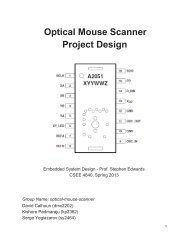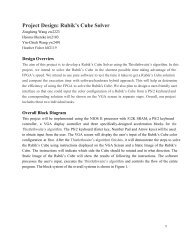Verilog and SystemC - Columbia University
Verilog and SystemC - Columbia University
Verilog and SystemC - Columbia University
You also want an ePaper? Increase the reach of your titles
YUMPU automatically turns print PDFs into web optimized ePapers that Google loves.
Hardware Description Languages Compared: <strong>Verilog</strong> <strong>and</strong> <strong>SystemC</strong><br />
Gianfranco Bonanome<br />
<strong>Columbia</strong> <strong>University</strong><br />
Department of Computer Science<br />
New York, NY<br />
Abstract<br />
As the complexity of modern digital systems<br />
increases, engineers are now more than ever<br />
integrating component modeling by means of<br />
hardware description languages (HDLs) in the<br />
design process. The recent addition of <strong>SystemC</strong> to<br />
an already competitive arena of HDLs dominated<br />
by <strong>Verilog</strong> <strong>and</strong> VHDL, calls for a direct<br />
comparison to expose potential advantages <strong>and</strong><br />
flaws of this newcomer. This paper presents such<br />
differences <strong>and</strong> similarities, specifically between<br />
<strong>Verilog</strong> <strong>and</strong> <strong>SystemC</strong>, in effort to better categorize<br />
the scopes of the two languages. Results are based<br />
on simulation conducted in both languages, for a<br />
model with equal specifications.<br />
Introduction<br />
Continuous advances in circuit fabrication<br />
technology have augmented chip density,<br />
consequently increasing device complexity. This<br />
has resulted in a higher degree of design<br />
automation <strong>and</strong> increase in the number of tools<br />
available to an integrated chip designer. Recently<br />
there has been an incline toward the usage of<br />
Hardware Description Languages [3]. The<br />
portability of models created with such tools, has<br />
made them preferable over their corresponding<br />
flow, state <strong>and</strong> logic diagrams.<br />
Various HDLs with diverse properties <strong>and</strong><br />
objectives have been developed over the years,<br />
giving designers a vast selection in the appropriate<br />
modeling instrument.<br />
<strong>SystemC</strong> presents a new approach to the<br />
concept of HDLs, as it combines hardware <strong>and</strong><br />
software descriptions at different levels of<br />
abstraction, by extending C++ with a new<br />
library.<br />
This library encompasses all of the necessary<br />
components required to transform C++ into a<br />
hardware description language. Such additions<br />
include constructs for concurrency, time notion,<br />
communication, reactivity <strong>and</strong> hardware data<br />
types.<br />
As described by Edwards [1], VLSI<br />
verification involves an initial simulation done in<br />
C or C++, usually for proof of concept purposes,<br />
followed by translation into an HDL, simulation of<br />
the model, applying appropriate corrections,<br />
hardware synthesization <strong>and</strong> further iterative<br />
refinement. <strong>SystemC</strong> is able to shorten this<br />
process by combining the first two steps.<br />
Consequently, this also decreases time to market<br />
for a manufacturer.<br />
Generally a comparison between two<br />
computer languages is based on the number of<br />
lines of code <strong>and</strong> execution time required to<br />
achieve a specific task, using the two languages. A<br />
number of additional parameters can be observed,<br />
such as features, existence or absence of constructs<br />
that facilitate coding, availability of optimization<br />
techniques, as well as others. These criteria vary<br />
slightly when attempting to compare two HDLs.<br />
For instance, HDLs need to have time-h<strong>and</strong>ling<br />
constructs, unlike most other computer languages.<br />
Comparable “building blocks” may synthesize into<br />
different circuitry, depending on the language’s<br />
st<strong>and</strong>ard.<br />
Other points utilized as a basis for comparison<br />
include: efficiency of methods <strong>and</strong> language<br />
constructs, signal behavior description, scheduling<br />
semantics <strong>and</strong> ease of implementation.<br />
In this paper I will be comparing different<br />
aspects between the <strong>Verilog</strong> [2] <strong>and</strong> <strong>SystemC</strong> [4]<br />
HDLs, according to the measures mentioned<br />
above. The code that will be used to base this<br />
comparison implements an alarm clock controller.
Related work<br />
Previous work comparing two or more HDLs is<br />
limited to a few papers, usually regarding VHDL<br />
<strong>and</strong> <strong>Verilog</strong>. This is mainly due to the fact that<br />
<strong>SystemC</strong> is a latecomer to this field, but also<br />
because it is merely an extension of an already<br />
existing language.<br />
Douglas Smith wrote a tutorial [5] in which he<br />
compares VHDL <strong>and</strong> <strong>Verilog</strong>. Smith also describes<br />
the range of modeling capacity possessed by the<br />
two languages, exposing VHDL’s lower modeling<br />
limit: gate level. Interestingly enough, <strong>Verilog</strong> is<br />
one of the few HDLs capable of modeling down to<br />
transistor level.<br />
Few additional papers dealing with two or<br />
more HDLs exist, but are generally not meant to<br />
bring forth comparison issues, rather to present<br />
co-design techniques such as Agliada [8].<br />
In his paper on co-simulation of VHDL <strong>and</strong><br />
<strong>SystemC</strong>, Agliada introduces a method to<br />
homogenize the system descriptions in order to<br />
simulate them together. This approach calls for a<br />
VHDL to <strong>SystemC</strong> translator. In describing such a<br />
tool, it is unavoidable to compare the two<br />
languages, even if not in detail.<br />
Fundamental differences in constructs<br />
Both <strong>Verilog</strong> <strong>and</strong> <strong>SystemC</strong> utilize modules as<br />
design entities While <strong>Verilog</strong> has the module<br />
keyword build in, <strong>SystemC</strong> needs to call a<br />
construct named sc_module() to declare the body<br />
of the device at task. The difference in module<br />
declaration syntax can be seen below in figure 1.<br />
<strong>Verilog</strong><br />
module runner(port names);<br />
//port sizes <strong>and</strong> direction<br />
//body<br />
endmodule<br />
Figure 1. Component declaration syntax.<br />
<strong>SystemC</strong><br />
SC_MODULE(Runner) {<br />
//ports sizes <strong>and</strong> direction<br />
//body<br />
};<br />
//member functions<br />
Although <strong>Verilog</strong> may appear slightly more<br />
concise at first, it should be pointed out that the<br />
former requires ports to be listed once in the<br />
module declaration line, <strong>and</strong> again immediately<br />
after, to specify their sizes. <strong>SystemC</strong> accomplishes<br />
this in one step, but at its own can declare a<br />
function separately from its body, as in C. This<br />
property of the language can also be viewed as an<br />
advantage, since a module can therefore call<br />
several different processes. <strong>Verilog</strong> is only able to<br />
carry out a process if found within a module,<br />
which signifies having to write a module for every<br />
process that needs to be called by external<br />
modules. The absence of a high level construct<br />
that replicates structure can often lead into<br />
writing code that may seem repetitive, or difficult<br />
to optimize.<br />
When modeling a process in <strong>Verilog</strong>, common<br />
practice is to have an always construct around the<br />
body of the function to be evaluated. In <strong>SystemC</strong>,<br />
the functions are written as members of the<br />
module class being designed, allowing the designer<br />
to more easily integrate additional functionality in<br />
the same design.<br />
Timing mechanisms vary extensively between<br />
<strong>Verilog</strong> <strong>and</strong> <strong>SystemC</strong>. The later has a built-in<br />
clocking mechanism, where such a device <strong>and</strong> its<br />
output signal wave can be described using the<br />
sc_clock() construct. Instead, <strong>Verilog</strong> uses a more<br />
general way to create a clock: by defining it as a<br />
module. Although this technique may appear<br />
inefficient, it is actually more natural for a<br />
beginning designer, since no new constructs need<br />
to be learned. Figure 2 below, illustrates this<br />
point.<br />
<strong>Verilog</strong><br />
<strong>SystemC</strong><br />
module m555 (clock); sc_clock m555("m555",<br />
output clock;<br />
20, 0.5, 5, true);<br />
reg clock;<br />
initial<br />
#5 clock = 1;<br />
always<br />
#50 clock = ~clock;<br />
endmodule<br />
Figure 2. Clock declaration syntax.<br />
<strong>SystemC</strong> allows for three types of processes to<br />
be utilized in the description of a model: methods,<br />
threads <strong>and</strong> synchronized threads.<br />
According to the <strong>SystemC</strong> User’s Guide [4],<br />
methods execute when changes occur in signals<br />
found in their sensitivity list. Upon termination, a<br />
method returns control to the simulation kernel.<br />
Threads behave similarly as methods, but they<br />
may also be suspended <strong>and</strong> reactivated at the
occurrence of a specified event. As Edwards [1]<br />
points out, hardware does not exhibit this<br />
behavior, but such processes can be useful when<br />
designing a test bench.<br />
Synchronous threads are a special case of<br />
threads, where triggering takes place at a specific<br />
edge of a signal. The scheduling of all three<br />
process types takes place at the bottom portion of<br />
a <strong>SystemC</strong> model, by using the sc_ctor() macro<br />
(<strong>SystemC</strong> constructor). In modeling an alarm<br />
clock controller, such a constructor was called for<br />
the tick process of type method:<br />
sc_ctor ( Runner ) {<br />
sc_method ( tick );<br />
sensitive_pos ( clock );<br />
}<br />
where Runner is the name of the sc_module that<br />
owns the tick process.<br />
<strong>Verilog</strong> per se does not differentiate among<br />
processes, but allows flexibility to mimic the<br />
behavior found in the three scenarios described<br />
above. This is achieved by means of timingoriented<br />
constructs such as:<br />
always @ ( condition )<br />
Here the condition may be a signal or an<br />
event, in which case the identifier will be found<br />
between parentheses. By this token, a function<br />
can also be edge-triggered:<br />
always @ ( posedge clock )<br />
As strongly-typed languages, both <strong>Verilog</strong> <strong>and</strong><br />
<strong>SystemC</strong> support signals as well as variables. They<br />
do differ in the built-in types available to the user.<br />
<strong>Verilog</strong> subdivides its data types into two main<br />
categories: registers <strong>and</strong> nets. A register type<br />
involves storage <strong>and</strong> consists of the following<br />
variants:<br />
reg<br />
integer<br />
time<br />
real<br />
unsigned variable of any bit size<br />
signed 32-bit variable<br />
unsigned 64-bit variable<br />
double-precision floating point<br />
wire or tri Simple interconnecting wire<br />
wor or trior Wired outputs OR together<br />
w<strong>and</strong> or tri<strong>and</strong> Wired outputs AND together<br />
tri0<br />
Pulls down when tri-stated<br />
tri1<br />
Pulls up when tri-stated<br />
supply0 Constant logic 0 (supply strength)<br />
supply1 Constant logic 1 (supply strength)<br />
trireg Stores last value when tri-stated<br />
(capacitance strength)<br />
In order to support modeling at different levels<br />
of abstraction, from the functional to the registertransfer<br />
level, as well as to support software,<br />
<strong>SystemC</strong> provides programmers with a rich set of<br />
signal types. This is different from languages like<br />
<strong>Verilog</strong> that only support bit-vectors as types.<br />
<strong>SystemC</strong> can implement both two-valued <strong>and</strong><br />
four-valued signal types, which add practicality to<br />
a simulation.<br />
<strong>SystemC</strong>’s set of data types is enhanced to<br />
support multiple design domains <strong>and</strong> abstraction<br />
levels. The fixed precision types allow for fast<br />
simulation. The arbitrary precision types can be<br />
used for computations with large numbers <strong>and</strong> to<br />
model large busses. Such types do not have a<br />
limitation in size.<br />
In addition, this HDL provides a large<br />
selection of overloaded operators, quantization <strong>and</strong><br />
overflow modes, as well as type conversion<br />
mechanisms.<br />
<strong>SystemC</strong>, extends C++ types by utilizing the<br />
following signal definition syntax:<br />
sc_signal < base_type > signal_name;<br />
where base_type corresponds to one of C++’s<br />
base types, such as integer, real, char, etc.<br />
Likewise, ports are declared with the same syntax,<br />
but utilize the identifiers sc_in, sc_out or<br />
sc_inout.<br />
As in C or C++, a <strong>SystemC</strong> description can<br />
include user-defined libraries containing functions<br />
<strong>and</strong> data structures, to employ throughout a<br />
program. <strong>Verilog</strong> offers no such reusability<br />
feature, which in certain cases can be a drawback.<br />
This is mainly due to the language’s interpretive<br />
nature.<br />
Nets (or wires) are of a larger variety:
Creating Descriptions<br />
Intuitively, <strong>Verilog</strong> can be very efficient in<br />
structural designs, as the language possesses<br />
moderately uncomplicated port-mapping <strong>and</strong><br />
module instantiation techniques. Switching<br />
between layers of abstraction can be confusing at<br />
times, since no dedicated constructs exist to aid<br />
the modeling of larger designs. For this reason, the<br />
structure of the description may appear the same<br />
throughout, regardless of component hierarchy.<br />
<strong>SystemC</strong> introduces a bit more discipline in<br />
large system modeling, by means of special<br />
constructs. The ability of declaring a sc_main()<br />
routine that manages all of the other modules,<br />
clocking <strong>and</strong> data transfer schemes, is a major<br />
advantage. This also facilitates the debugging<br />
process of the very same descriptions.<br />
At the same time, its object-oriented<br />
sequential origins make <strong>SystemC</strong> suitable for<br />
behavioral designs. This introduces a new concept<br />
in system design: the co-simulation of a piece of<br />
hardware <strong>and</strong> its embedded software, using the<br />
same language. It is now possible to implement,<br />
for example, a controller <strong>and</strong> its driver all under<br />
the same roof.<br />
Beginners will find <strong>Verilog</strong> easier to learn, due<br />
to its generalized syntax. It also does not require<br />
the user to be familiar with other languages that<br />
the HDL was based on, as is the case with<br />
<strong>SystemC</strong> <strong>and</strong> C++.<br />
Simulation semantics<br />
while there are<br />
events<br />
while there are<br />
active events<br />
Inactive events<br />
non-blocking<br />
assign events<br />
Activate<br />
monitoring events<br />
while there are<br />
active events<br />
Update event<br />
process<br />
evaluation event;<br />
Advance<br />
Time<br />
Activate them<br />
Activate them<br />
update the<br />
changed object;<br />
schedule any<br />
evaluation<br />
events for<br />
sensitive<br />
processes;<br />
<strong>Verilog</strong> <strong>and</strong> <strong>SystemC</strong> adopt different<br />
simulation semantics. <strong>Verilog</strong> utilizes an eventdriven<br />
scheduler, which obeys the rules illustrated<br />
by the graph in figure 3. Here we see nested loops<br />
executing in zero-time, which translates directly<br />
into slower execution times during simulation,<br />
than those of a cycle-based scheduler. Although<br />
proven competent, such a set of semantics is at<br />
times a drawback on performance, as several<br />
actions are expected to take place in each clock<br />
cycle.<br />
Figure 3. <strong>Verilog</strong> Simulation Semantics.<br />
In comparison, <strong>SystemC</strong>’s cycle-based<br />
simulation semantics are much simpler, as<br />
overhead for different types of events is<br />
eliminated. Overall scheduling is more efficient, as<br />
timing information is done away with. The graph<br />
adaptation from Mueller [7] illustrates below:
Clock Update<br />
Update outputs<br />
of newly<br />
triggered sync.<br />
processes<br />
Execute all<br />
async.<br />
processes whose<br />
inputs just<br />
changed<br />
Figure 4. <strong>SystemC</strong> Simulation Semantics.<br />
Language Determinism<br />
The <strong>Verilog</strong> simulation model pictured above<br />
guarantees a certain level of determinism over the<br />
scheduling order.<br />
Statements located within a begin-end block<br />
are guaranteed to execute sequentially in the order<br />
listed inside such a begin-end block. Although a<br />
process may very well suspend itself at a certain<br />
event <strong>and</strong> later regain control, its statements will<br />
still be executed in the order listed within the<br />
begin-end block.<br />
Non-blocking assignments will always be<br />
performed in the order that the statements were<br />
to be executed. For example:<br />
initial begin<br />
A
module communication may be alternatively<br />
implemented to take advantage of this well<br />
developed feature.<br />
<strong>SystemC</strong> presents potential for shorter<br />
simulation times, as its scheduling algorithm is<br />
based on process type, avoiding timing overhead.<br />
Shorter simulation times combined with a reduced<br />
verification stage, make <strong>SystemC</strong> the favorable<br />
out of the two, for very large designs. This is<br />
especially true since <strong>Verilog</strong> lacks high level<br />
constructs that facilitate such a design process.<br />
In general <strong>Verilog</strong> is better suited for<br />
structural designs, as it allows for better control of<br />
modules within the same abstraction layers, even<br />
though it lacks component hierarchy management.<br />
<strong>SystemC</strong>’s nature is behavioral, which can make it<br />
more difficult to synthesize than <strong>Verilog</strong>.<br />
Verification process in larger designs is shorter<br />
for <strong>SystemC</strong>, as no C/C++ simulation needs to be<br />
implemented, hence decreasing the time to<br />
market.<br />
References<br />
[1] S. Edwards. Languages for Embedded Systems.<br />
Kluwer 2000.<br />
[2] T. Kropf. The <strong>Verilog</strong> Hardware Description<br />
Language. Kluwer 1996.<br />
[3] G. DeMicheli. Synthesis <strong>and</strong> Optimization of<br />
digital circuits. McGraw Hill 1994.<br />
[4] Synopsys. <strong>SystemC</strong> version 2.0 User’s guide.<br />
2000.<br />
[5] D. Smith. VHDL & <strong>Verilog</strong> Compared &<br />
Contrasted. Proc. 33rd Design Automation<br />
Conf., 1996.<br />
[6] System-on-Chip Specification <strong>and</strong> Modeling<br />
Using C++. ICCAD 2000 Roundtable.<br />
[7] W. Mueller. The Simulation Semantics of<br />
<strong>SystemC</strong>. Proc. Design, Automation, <strong>and</strong> Test<br />
in Europe (DATE 2001), Munich, Germany,<br />
March 2001.<br />
[8] N. Agliada, A. Fin. F. Fummi M. Martignano.<br />
G. Pravadelli. On the Reuse of VHDL Modules<br />
into <strong>SystemC</strong> Designs. Proc. IEEE Forum on<br />
Design Languages (FDL), Lyon, France 2001.<br />
[9] S. Swan. An Introduction to System Level<br />
Modeling in <strong>SystemC</strong> 2.0. Cadence Design<br />
Systems, Inc. May 2001.







